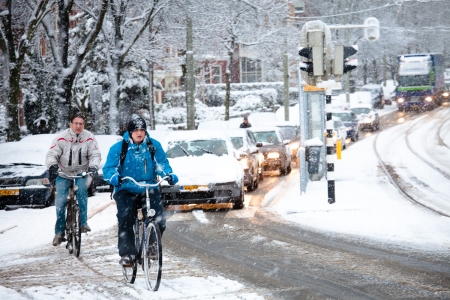The measures that can reduce adverse effects of weather on road safety are very diverse. We successively discuss infrastructural measures, vehicle-related measures, regulations, and education/training. Quantitative information on the effects of these types of measures is generally not available.
Infrastructure
For driving in rain, good drainage is very important. Very porous asphalt provides this good drainage. In the Netherlands, it is mainly used on motorways and sometimes on 80 km/h roads. Very porous asphalt is less suited for frost because it becomes slippery sooner than other types of asphalt. This is because the open structure allows the cold to penetrate the asphalt more quickly and ground-source heat has less effect, causing the road surface to freeze faster. The open structure also causes road salt to dilute faster and wash away sooner.
For driving in rain, it is also important that there are no ruts where rainwater remains. The combination of ruts and very heavy rain can easily result in aquaplaning. This involves a layer of water between the road surface and the tyres, causing the vehicle to lose grip on the road surface.
Timely and adequate de-icing helps prevent crashes due to slipperiness. This certainly applies to bicycle tracks and roads that are frequently used by cyclists. In addition to slipperiness due to snow, sleet and frost, it can also be due to, for example, mud or wet leaves on the road. Keeping roads and in particular bicycle tracks clean will therefore also help to prevent those kinds of slipperiness-related crashes.
Finally, local warning signs and other informational signs may help alert road users to specific local risks, such as skidding hazards, slippery snow and sleet, risk of crosswinds, rutting or mud on the road. Sometimes, there is also a lower local speed limit with a plate below the speed limit sign indicating that it only applies in rain or wet road conditions.
Vehicle (technology)
Motor vehicles have several tools to reduce the most immediate effects of adverse weather conditions. These include maintaining adequate visibility (windshield wipers, air conditioning), being sufficiently visible to others (general lighting, fog lights), maintaining grip on the road (tyres with sufficiently deep tread) and avoiding extreme temperatures inside the vehicle (heating, air conditioning). Spray-suppression is mandatory for trucks (of 7.5 tons and above) and for trailers (of 3.5 tons and above). This limits water spray from the tyres. The safety effect of winter tyres is unclear (see the question What is the effect of winter tyres?).
Many cars have a system that visually or audibly indicates that the outside temperature is heading toward or below zero. With the increasing ability to provide vehicles with real-time information (communication between vehicles (V2V) and between vehicles and infrastructure (V2I and I2V)), the ability to warn individual drivers of current or imminent bad weather conditions is also increasing. Several simulator studies have found positive effects of this communication on, for example, speed choice (e.g., [27] [28]), but increasing task load (additional information that must be responded to) is a concern [29].
Regulations
In some countries, the general speed limit changes with current or expected bad weather conditions. A few examples: in France, for example, the general limit on motorways drops from 130 to 110 km/h in case of rain and snow, and from 80 to 70 km/h on rural roads. On wet motorways in Germany, there is a (lower) limit at some locations. The Netherlands also has similar local speed limits for wet roads. Finland uses lower limits in winter than in summer: 100 instead of 120 km/h on motorways and 80 instead of 100 km/h on main roads in rural areas. Estonia, Latvia and Lithuania also have lower limits in winter.
More and more countries, including the Netherlands, use matrix displays to introduce temporarily lower speed limits in case of (current) bad weather conditions such as slipperiness, fog or strong winds. Speed limits on matrix displays have an important signal function and lead to more homogeneous speeds, a decrease in the number of crashes and near crashes and to less intensive braking manoeuvres (see SWOV fact sheet Speed and speed management).
Public communication & training
In the Netherlands, the Dutch national weather service KNMI warns of expected bad weather conditions for traffic, among other things, using the codes yellow, orange and red. Warnings are regional, usually by province. Code yellow (be alert) may be issued 48 hours before the weather phenomenon occurs with a certainty of at least 60%. Code orange (be prepared) may be issued 24 hours in advance, likewise at a certainty of at least 60%. Code red (take action) is not issued sooner than 24 hours before the weather phenomenon occurs, even if there is a low probability but high safety risk. For details on the type of weather conditions for which a warning is issued, see the KNMI website [30].
The effect of the code warnings on mobility and/or behavioural choices in traffic is not known.
In addition to these specific warnings, there is also more general advice (in case of slipperiness: keep your distance, look far ahead, accelerate slowly, and apply maximum, non-pumping braking) and slogans (“in case of fog: double your distance, halve your speed"). To what extent people are aware of this type of advice, and are able and willing to take heed, is not known.
In general, road users receive little or no training in dealing with bad weather. There is very little opportunity of practising in bad weather during driver training. Various skid courses are offered for cars and also for motorcycles, one of the aims of which is to teach drivers to cope with bad weather conditions. However, skid courses have often proved counterproductive: they are too short to automate the complex, sometimes counter-intuitive, actions required to control a car when skidding, while after the course people do trust their ability to do so and therefore take more risks in slippery or heavy rain (see SWOV fact sheet Driver training and driving tests).
